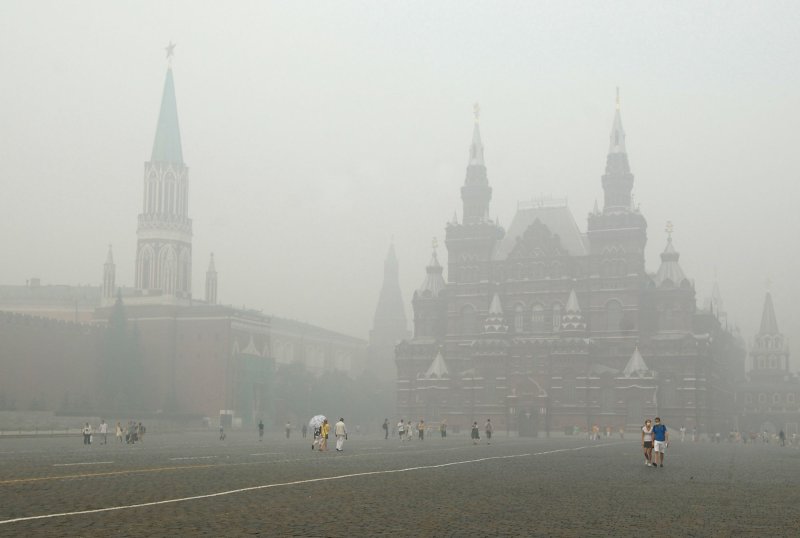1 of 2 | Moscow Kremlin and the Central history museum on Red Square are seen through a heavy smog on August 6, 2010. Russian capital was blanketed in record thick smoke causing by temperatures up to 100 F (38 C) and several days of nearby forest and peat fires. UPI/Alex Volgin |
License Photo
BERLIN, Aug. 12 (UPI) -- The Russian wild fires have burned in forests contaminated by the Chernobyl nuclear accident but experts say fears of a dangerous radioactive ash cloud are overblown.
The Russian Emergency Ministry Thursday announced that it had managed to put out wildfires in the forests in Bryansk, an area contaminated by the 1986 Chernobyl nuclear disaster, after the fires had raged there Wednesday.
A German radiation expert said the local population should observe official radiation warnings carefully but he added that most people have nothing to fear.
"The contamination in the vegetation might have remobilized and spread geographically but, as a result, it also becomes less concentrated," Ulrich Abram, a chemistry professor at Berlin's Free University, told United Press International in a telephone interview Friday.
The expert added the contamination with cesium and strontium in the Bryansk area -- once 10 times above German levels -- has roughly halved in the almost 2 1/2 decades since the April 26, 1986, accident at the Chernobyl reactor.
"The rest of Europe won't be affected by the fires in the contaminated areas," Abram said.
Meanwhile, Russia's fight against the wildfires seems to be increasingly successful. The Emergency Ministry said Thursday that it had significantly reduced the area covered with fire to 80,000 hectares, down from 196,000 hectares a week ago.
Nearly 200,000 people and dozens of planes are taking part in the Russian firefighting operation but it has proven an uphill battle.
The fires, aided by a severe drought and the hottest summer since temperature recordings began 130 years ago, have destroyed residential houses, military facilities, and claimed the lives of more than 50 people. In Moscow, which has been affected by thick smog from the fires surrounding the city, the mortality rate has doubled.
The agriculture sector has been hardest hit. Russian President Dmitry Medvedev has promised farmers aid worth $1.15 billion after one-quarter of grain crops in the country have been destroyed by the fires.
The fires have been raging for weeks in several provinces of the country, devastating the overall economy by creating short-term losses of an estimated $15 billion.
Yet there is hope that all will be over soon. The weather is beginning to cool down, experts said.
"The high pressure system over central Russia will start dissipating next Tuesday. For the first time since June 21 we are noticing changes in the atmospheric circulation," Roman Vilfand, the head of the Russian state meteorological center, told Russian news agency RIA Novosti.





